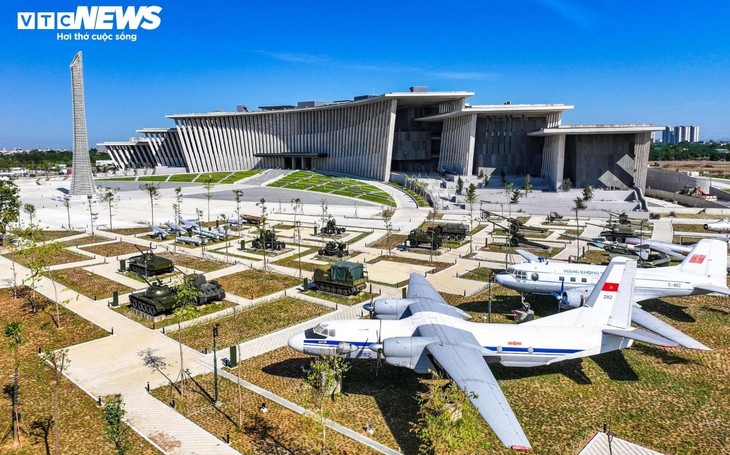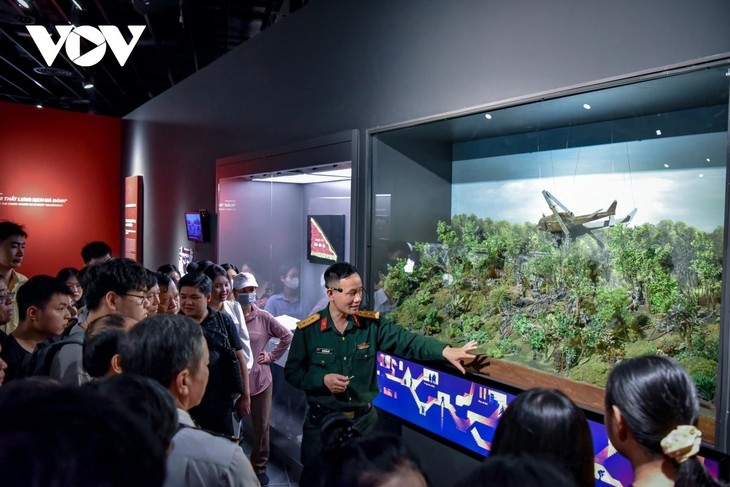(VOVWORLD) - As of November 1, 2024, the Vietnam Military History Museum is opened to the public. The museum, a project of major cultural significance, gives an insight into the struggle for national independence of the Vietnamese people, as well as Vietnam’s military heritage, meeting the educational and sightseeing needs of domestic and international visitors.
 The newly built Vietnam Military History Museum in Nam Tu Liem district, Hanoi. Photo: (VTC News) The newly built Vietnam Military History Museum in Nam Tu Liem district, Hanoi. Photo: (VTC News) |
The newly built Vietnam Military History Museum is located on a 74-hectare site along Thang Long Boulevard in Nam Tu Liem District, Hanoi. The outdoor area features a 45-metre Victory Tower, with multiple layers forming a five-pointed star, symbolizing the year 1945 — when President Ho Chi Minh read the Declaration of Independence to establish the Democratic Republic of Vietnam.
Parts of a plane shot down by the Vietnamese army in Hanoi are displayed and decorated with flying doves, a symbol of the peace-loving Vietnam and its people.
Among the more than 150,000 artifacts preserved at the museum, four of which have been recognized as national treasures.
First is the MiG-21 fighter jet numbered 4324, with 14 stars on its nose, symbolizing its 14 victories against American aircraft. Next, there is the MiG-21 fighter jet numbered 5121, piloted by Hero of the People's Armed Forces Pham Tuan, who shot down a US B-52 bomber on the night of December 27, 1972.
Another national treasure is the T-54B tank numbered 843 that crashed through the gates of the Independence Palace on April 30, 1975. Finally, there is a map of the Ho Chi Minh Campaign, which led to the complete liberation of southern Vietnam and the reunification of the country. These artifacts have left a deep impression on visitors, who said:
One visitor said, "About the materials, some of them are pretty old. And in my country we cannot find them. There’s a T54 outside and even the MiG. I have never seen a MiG."
"Through the museum, I saw the greatness of the Vietnamese people’s war. I served during the "Dien Bien Phu in the air" campaign and was in Bac Ninh at the time to help people in Dong Anh evacuate to Bac Ninh province,” another shared.
The museum is designed in a modern style with four above-ground floors and one basement. Its indoor exhibition space on the first floor is divided into six main themes, covering the nation's history from its early days to today’s national construction and defense. Each theme is meticulously designed to create a vivid panoramic view of history.
Lieutenant Colonel Nguyen Thi Lan Huong, head of the museum's Public Relations and Education Department, said, “The museum uses modern display techniques, with 3D mapping technology, interactive screens with search and annotating functions, as well as articles for visitors to learn more about historical events.”
Visitors are free to explore and experience an interactive space connecting the past with the present through an automatic audio guide system and QR codes for each artifact.
Additionally, there are more than 60 video clips showcasing various campaigns and battles, as well as featuring the lives and fighting spirit of Vietnamese soldiers. Lieutenant Colonel Huong added, "The search function allows visitors to see each battle and campaign within a historical period. For example, we have footages of the 1968 Spring Offensive, through which visitors can see real artifacts, real photo documents, and stories of the event.”
 Visitors listen to an introduction to the tunnels used during Vietnam's resistance war. (Photo: VOV.) Visitors listen to an introduction to the tunnels used during Vietnam's resistance war. (Photo: VOV.) |
The modern display offers visitors a unique and dynamic experience. One visitor said: "Technology applications help young people obtain real experiences through images and better understand history."
A foreign visitor shared: “An exhibition like this is very good because then so many people can know about the country of Vietnam and the history of Vietnam. I have been studying the modern era strategically on the military side so I'm really interested in that.”
The Vietnam Military History Museum glorifies the great feats of arms of the Vietnam People's Army and instills pride in the thousand-year old tradition of national defense of the Vietnamese people.